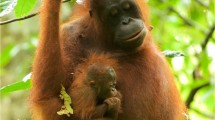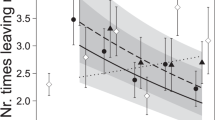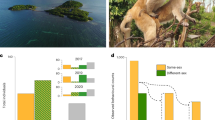Abstract
Much evidence now suggests that the postnatal killing of young in primates1–4 and carnivores5,6, and induced abortions in some rodents7–9, are evolved traits exerting strong selective pressures on adult male and female behaviour. Among ungulates it is perplexing that either no species have developed convergent tactics or that these behaviours are not reported, especially as ungulates have social systems similar to those of members of the above groups10,11. Only in captive horses (Equus caballus) has infant killing been reported12. It has been estimated that 40,000 wild horses live in remote areas of the Great Basin Desert of North America (US Department of Interior (Bureau of Land Management), unpublished report), where they occur in harems (females and young) defended by males13–15. Here I present evidence that, rather than killing infants directly, invading males induce abortions in females unprotected by their resident stallions and these females are then inseminated by the new males.
This is a preview of subscription content, access via your institution
Access options
Subscribe to this journal
Receive 51 print issues and online access
$199.00 per year
only $3.90 per issue
Buy this article
- Purchase on Springer Link
- Instant access to full article PDF
Prices may be subject to local taxes which are calculated during checkout
Similar content being viewed by others
References
Hrdy, S. B. Ethol. Sociobiol. 1, 13–40 (1979).
Chapman & Hausfater, G. Behavl Ecol. Sociobiol. 5, 227–240 (1979).
Hrdy, S. B. The Langurs of Abu (Harvard University Press, Cambridge, 1977).
Sherman, P. W. in Natural Selection and Social Behavior (eds Alexander, R. D. & Tinkle, D. W.) 311–331 (Chiron, New York, 1980).
Bertram, B. C. R. J. Zool. 177, 463–482 (1975).
McCullough, D. R. in Dynamics of Large Mammal Populations (eds Fowler, C. & Smith, D.) 173–196 (New York, 1981).
Bruce, B. M. J. Reprod. Fert. 1, 96–103 (160).
Mallory, F. F. & Brooks, R. J. Nature 273, 144–146 (1978).
Stehn, R. A. & Richmond, M. E. Science 187, 1210–1211 (1975).
Wilson, E. O. Sociobiology; The New Synthesis (Belknap, Cambridge, Massachusetts, 1975).
Eisenberg, J. F. The Mammalian Radiations (University of Chicago Press, 1981).
Duncan, P. Appl. Anim. Ethol. 8, 567–570 (1982).
Berger, J. Behavl Ecol. Sociobiol. 2, 131–146 (1977).
Houpt, K. A. & Keiper, R. R. J. Anim. Sci. 54, 945–950 (1982).
Rubenstein, D. I. Equine vet. J. 13, 27–34 (1981).
Miller, R. & Denniston, R. H. Z. Tierpsychol. 51, 41–47 (1979).
Estep, D. Q. & Bruce, K. E. Anim. Benav. 29, 1272–1273 (1981).
Gowaty, P. A. Anim. Behav. 30, 630–631 (1982).
Hilton, D. F. J. BioScience 32, 641 (1982).
Ginther, O. J. Reproductive Biology of the Mare (McNaughton, Ann Arbor, 1979).
Dawkins, R. The Selfish Gene (Oxford, New York, 1976).
Wittenberger, J. F. Animal Social Behavior (Duxbury, Belmont, California, 1981).
Krebs, J. R. & Davies, N. B. An Introduction to Behavioural Ecology (Sinauer Ass., Duxbury, Massachusetts, 1981).
Hafez, E. S. E. Reproduction in Farm Animals (Fea & Febinger, Philadelphia, 1980).
Ginther, O. J., Whitmore, H. L. & Squires, E. L. Am. J. vet. Res. 33, 1935–1939 (1972).
Nishikawa, Y. in Reproduction in Farm Animals 3rd edn (ed. Hafez, E. S. E.) 288–300 (Fea & Febinger, Philadelphia, 1974).
Rossdale, P. D. The Horse (J. A. Allen, London, 1975).
Howell, C. E. & Rollins, W. C. J. Anim. Sci. 10, 789–796 (1951).
Ropiha, R. T., Mathews, R. M. & Butterfield, R. M. Vet. Rec. 84, 552–559 (1969).
Rollins, W. C. & Howell, C. E. J. Anim. Sci. 10, 797–804 (1951).
Nishikawa, Y. Studies on Reproduction in Horses (Jap. Racing Ass., Tokyo, 1959).
Kiltie, R. A. J. Mammal. 63, 646–652 (1982).
Schwagmeyer, P. L. Am. Nat. 114, 932–938 (1979).
Clutton-Brock, J. Domesticated Animals from Early Times (Br. Mus. nat. Hist., London, 1981).
Axelrod, D. I. Univ. Calif. Publs geol. Sci. 74, 1–42 (1967).
Penzhorn, B. L. thesis, Univ. Pretoria (1975)
Klingel, H. Zoologica Afr. 4, 249–263 (1969).
Mohr, E. The Asiatic Wild Horse (J. A. Allen, London, 1971).
Groves, C. P. Horses, Asses, and Zebras in the World (Ralp Curtis, Hollywood, 1974).
Ryder, O. A. & Wedemeyer, E. A. Biol. Conserv. 22, 259–271 (1982).
Smuts, G. L. Koedoe 19, 89–132 (1976).
Author information
Authors and Affiliations
Rights and permissions
About this article
Cite this article
Berger, J. Induced abortion and social factors in wild horses. Nature 303, 59–61 (1983). https://doi.org/10.1038/303059a0
Received:
Accepted:
Issue Date:
DOI: https://doi.org/10.1038/303059a0
Comments
By submitting a comment you agree to abide by our Terms and Community Guidelines. If you find something abusive or that does not comply with our terms or guidelines please flag it as inappropriate.



